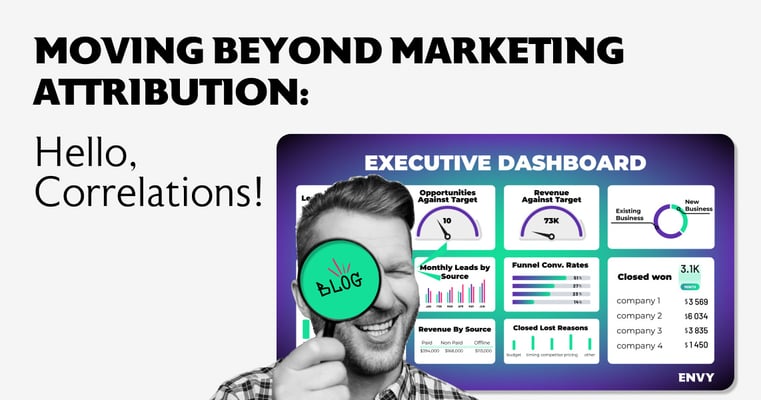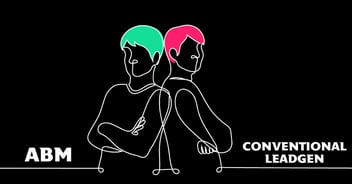
Moving Beyond B2B Marketing Attribution: Hello, Correlations!
It's a tale as old as time... B2B marketers have been trying to understand and measure the impact of their efforts for ages. We need it to optimize what we do, we need it to learn what to stick to, and we also need it cause management wants to see how we're progressing, or rather IF we are (happens to the best of us), how marketing activities are impacting the sales funnel. The thing is, the day when we clearly see what's what is still in front of us. So how do we measure progress???
Why marketing attribution (still) matters
Marketing attribution has been the bedrock of performance measurement for marketers from day zero. We’ve been using it ourselves as an experienced PPC agency. By attributing conversions to specific marketing touch points, you hope to understand which campaigns are driving results. And when/if you know which campaigns are driving results, you know where to invest more. It tells you about which channels work for your brand, gives you insights into your customer journeys, and so on. For example, if someone clicks on a Facebook ad and later makes a purchase, that conversion is attributed to the ad.
Simple, right? Nope.
The aim of marketing attribution is to determine which channels, campaigns, or messages have driven sales or conversions, that's clear. By analyzing this data, you can fine-tune your marketing efforts and boost the return on investment (ROI) for your campaigns, also clear. This allows you to channel your resources more effectively, ensuring that every dollar spent contributes to achieving your business objectives – yes, BUT focusing solely on these attribution models might skew the full picture.
Let’s try to put this into perspective. Marketing attribution has been used so widely that we’ve come up with different models that look specifically into what pushes prospects to move to the next step and become customers. We have first touch attribution, last touch attribution, multi-touch attribution, linear attribution… Here’s what’s wrong with all of them.
We’ve all been watching too much UEFA. You know how England beat Slovakia 2:1 earlier in June? They scored two goals. We’ll likely regret this comparison, but…
- First touch attribution model would assume that the first person who touched the ball caused England to win;
- Last touch attribution model means assuming the last person who touched the ball caused England to win;
- Linear attribution model would assume all players equally contributed to England’s win (and excuse us, but we’re not letting the cat among the pigeons…)
While this is greatly simplistic, it hopefully proves our point. Focusing too much on any of these specific touch points might make you lose sight of all the other interactions. You know what would help though? That’s right, correlations.
The need for correlations in today’s B2B marketing
Enter correlations. Correlations help us determine the relationship between different marketing activities and business outcomes, but unlike attribution models that attempt to pinpoint a direct cause-and-effect, correlations can show how one factor may indirectly influence another.
For example, a strong correlation between increased social media engagement and higher sales can prove the importance of social media efforts without attributing sales to a specific post or campaign. Why do we need it again?
- Today, everything in marketing (or business) is one huge web of touch points. You can't just attribute performance to a single activity on a single platform. Everything is connected. Correlations allow us to see these connections and understand how different touch points interact to drive conversions.
- We can no longer ignore dark social. All the shares and interactions that occur in private channels do take place, but traditional attribution models can't track them.
- With increasing data privacy regulations, first-party data has become more valuable. Again, something that has worked in the past is not able to accurately tell us the full story anymore.
How do we measure correlations in marketing?
See these charts above. When we kicked off a paid campaign, traffic to website grew across ALL sources, not just paid, and the sessions to contact rate skyrocketed, telling us that the traffic we’re sending is actually valuable. But traditional attribution models wouldn’t take this into consideration, would they?
So what are we looking at exactly? Correlations such as:
- Boost in traffic: kicking off campaigns should result in uplifts in traffic from organic, direct, and social channels, signalling broad engagement.
- Quality of traffic: The increase in session-to-contact rates suggests that this isn't just any traffic; it's the right kind.
- Brand visibility: As campaigns progress, brand searches spike, proving heightened awareness.
- Beyond inbound leads: Many leads interact with our ads before registering. It’s not just about inbound tactics; ad interactions are crucial.
Tools for measuring correlations
As for everything in marketing, there are tools 😉 Of course, you can never get enough of HubSpot dashboards and if you know your company and the market well enough, you can add 2 + 2 manually. But why would you, right?
Tools that come in handy and identify patterns and trends in your data are Google Analytics 4, Trendemon and Leadfeeder (aka Dealfront).
Correlations are not causations…
One thing that we feel we should mention is this. Just like you can easily fall victim to confirmation bias with traditional marketing attribution models, it’s possible to go one step too far with correlations too. A step so big that it sort of became a meme of its own.
Source: FastCompany
Is Miss America’s age across time causing the murders by steam to grow and drop? No. Just like your paid campaign isn’t directly causing your traffic to website to grow. It’s all interconnected, but A does not generate B. That’s all.
What we want you to take away from all this is simple. Don’t rely too heavily on marketing attribution models, they’ll skew the full picture. Connect the dots instead with correlations.
Need our help? You know where to find us.







